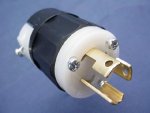Douglas Cox
Member
- Messages
- 6
- Location
- Apex, NC
I was wondering how people felt out using twist-lock (L6-20) plugs vs non twist-lock (6-20) plugs on their mostly-stationary power tools (table saw, bandsaw, jointer, etc)?
The table saw I have came with a 6-20 plug on it, but I need to make it a bit longer so I am debating using twist-locks on a new cable, and the jointer and bandsaw don't have plugs yet. (I haven't figured that reasoning out yet since they're all from Grizzly.)
The outlets I had installed were twist-lock because at the time I thought that would be a bit more secure, but then I started thinking that maybe that's not the best thing of somehow I managed to trip on one or drop a board on one.
Anyway, I was just wondering what people were using and what they thought the pros / cons were? The non twist-lock parts are certainly cheaper, but not by so much that it matters at this point.
Thanks,
-Doug
The table saw I have came with a 6-20 plug on it, but I need to make it a bit longer so I am debating using twist-locks on a new cable, and the jointer and bandsaw don't have plugs yet. (I haven't figured that reasoning out yet since they're all from Grizzly.)
The outlets I had installed were twist-lock because at the time I thought that would be a bit more secure, but then I started thinking that maybe that's not the best thing of somehow I managed to trip on one or drop a board on one.
Anyway, I was just wondering what people were using and what they thought the pros / cons were? The non twist-lock parts are certainly cheaper, but not by so much that it matters at this point.
Thanks,
-Doug






